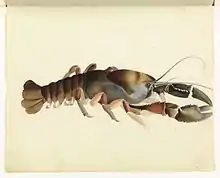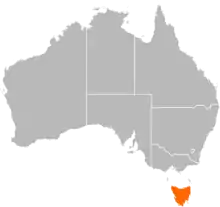Astacopsis
Astacopsis is a genus of crayfish endemic to the island of Tasmania. There are three extant species, Astacopsis gouldi, Astacopsis franklinii, and Astacopsis tricornis. All are threatened by illegal harvesting,[1][2][3] and A. gouldi is protected by law.[1] A. franklinii is found in the eastern half of the island,[2] with A. tricornis taking its place in the west.[3] A. gouldi is found only in rivers draining into the Bass Strait, except for the Tamar River.
| Astacopsis | |
|---|---|
 | |
| Watercolour of Astacopsis tricornis from "Sketchbook of fishes" by WB Gould | |
| Scientific classification | |
| Kingdom: | Animalia |
| Phylum: | Arthropoda |
| Subphylum: | Crustacea |
| Class: | Malacostraca |
| Order: | Decapoda |
| Superfamily: | Parastacoidea |
| Family: | Parastacidae |
| Genus: | Astacopsis Huxley, 1879 |
 | |
| Astacopsis distribution | |
The three species were named by naturalist Ellen Clark in 1936.[4] Prior to Clark's revision, all three species were collectively known as Astacopsis franklinii.[5][6] The most famous depiction of a crayfish of the genus Astacopsis is in the "Sketchbook of fishes" by convict artist William Buelow Gould, painted at the Macquarie Harbour penal station circa 1832. Based on the location of observation and morphology evident in the image the specimen Gould painted was A. tricornis.[7][5]
Contrary to popular belief, A. gouldi was not named after WB Gould, but was named by Ellen Clark after the first Tasmanian Government Geological Surveyor Charles Gould, who published observations on giant freshwater crayfish distribution, diet and habits in 1870.[8]
Extant Species
| Image | Scientific name | Common Name | Distribution |
|---|---|---|---|
 | Astacopsis gouldi | Tasmanian giant freshwater crayfish | northern Tasmania |
| Astacopsis franklinii | Eastern Tasmania | ||
| Astacopsis tricornis | Western Tasmania | ||
References
- "IUCN:Astacopsis gouldi".
- "IUCN:Astacopsis franklinii".
- "IUCN:Astacopsis tricornis".
- Clark, Ellen (1938). "The freshwater and land crayfish of Australia". Memoirs of the National Museum, Melbourne. 10: 5–58. doi:10.24199/j.mmv.1936.10.01. ISSN 0311-9548.
- Mulhern, TD (2018). "Correcting misconceptions about the names applied to Tasmania's giant freshwater crayfish Astacopsis gouldi (Decapoda: Parastacidae)". Papers and Proceedings of the Royal Society of Tasmania. 152: 21–26. doi:10.26749/rstpp.152.21.
- "J.E. Gray, 1845. In Eyre, E.J. Journals of Expeditions of Discovery into Central Australia, and Overland from Adelaide to King George's Sound, in the Years 1840-41. T. & W. Boone, London. - Reference Details - The Taxonomicon". taxonomicon.taxonomy.nl. Retrieved 2019-07-19.
- Hamr, P. (1992). "A revision of the Tasmanian freshwater crayfish genus Astacopsis Huxley (Decapoda: Parastacidae)". Papers and Proceedings of the Royal Society of Tasmania. 126: 91–94. doi:10.26749/rstpp.126.91. ISSN 0080-4703.
- Gould, Charles (1870). "On the distribution and habits of the large fresh-water crayfish (Astacus sp.) of the northern rivers of Tasmania". Monthly Notices of Papers & Proceedings of the Royal Society of Tasmania: 42–44.